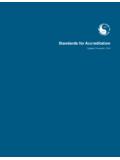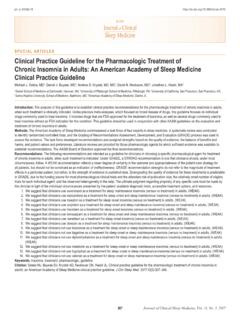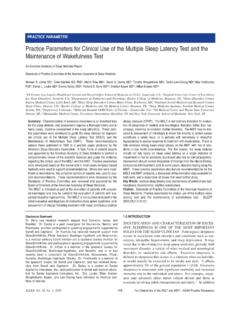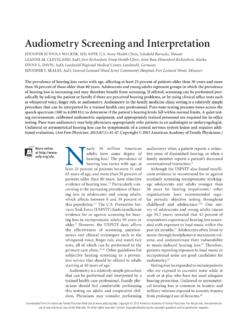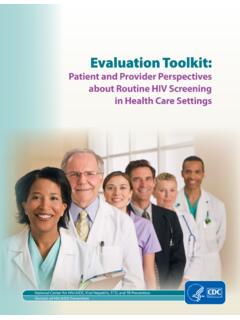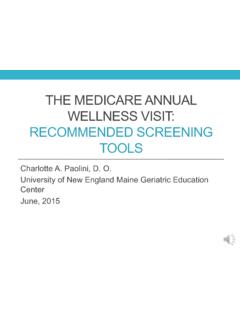Transcription of SCREENING QUESTIONS - SLEEP HISTORY & PHYSICAL
1 CHIEF COMPLAINT: As you already know, it is the reason forthe patient to be evaluated, usually in their own OF PRESENT ILLNESS: Just as in non- SLEEP relat-ed symptoms, you should describe their SLEEP symptoms in thecontext of the seven qualities of the symptoms, including:1. location of the symptoms2. quality of the symptoms3. quantity or severity of the symptoms4. timing (ie. onset, duration, frequency) of symptoms5. setting in which symptoms occur6. factors that aggravate or relieve symptoms7. associated manifestationsIn addition there are other significant aspects. These include: (A)the patient s bedmate s main complaint; (B) also indicate whetherthe patient estimates this problem to be mildly upsetting, moder-ately severe, or totally incapacitating, and how strongly do theywant help with this following are a series of SCREENING QUESTIONS that may helpyou determine the underlying cause of the patient s SLEEP disorder:1).
2 SCREENING QUESTIONS for SLEEP APNEA:A. Snoring: get quantitative measures. Are they heard out-side the bedroom? Is it worse on their back or on theirside? Do others complain about their snoring? Howmany nights per weeks does it occur?B. Has anyone witnessed the patient during an apneic event?(Have they been told that they stop breathing during SLEEP ,or is there a silent period when there is no longer snoringfollowed by a loud snort or a body jerk?) If so, how often?C. Ask whether they awaken from SLEEP short of breath orwith a feeling of being Do they have nocturnal diaphoresis?
3 E. Do they have a morning headache? If so, quantitate, andfind out how long it lasts. Where is it located?F. Do they have multiple nocturnal awakenings? (Whatwakes them up, when, how many times a night?)G. Get a record of their weight gain or loss over their lifetimeas well as their neck collar size in inches. Also ask themtheir Try to quantitate daytime sleepiness: (1) Do they fallasleep before noon if they are not active? (2) Do they fallasleep during active tasks before noon? (3) Do they expe-rience sleepiness after lunch? (4) Do they fall asleep dur-ing the afternoon if they are not active?
4 (5) Do they fallasleep during active tasks in the afternoon? (6) Do theyfall asleep while driving? (7) Do they have trouble fallingasleep during school or work? (8) Do they take naps uponarrival home from work? It is important to quantitatewhat activities they are doing when they fall asleep forinstance, watching are three subjective scales to quantitate daytime sleepinessincluding the Epworth Sleepiness Scale, the Stanford SleepinessScale, and the Analog Scale of Well Being: 2).SUBJECTIVE MEASURES OF SLEEPINESSa).EPWORTH SLEEPINESS likely are you to doze off or fall asleep in the following sit-uations, in contrast to feeling just tired.
5 Use the following scaleand indicate the most appropriate number for each situation:0 = would never doze1 = slight chance of dozing2 = moderate chance of dozing3 = high chance of dozingSituationChances of Dozing Sitting and reading____ Watching TV____ Sitting, inactive in a public place (ex: theatre or meeting)____ As a passenger in a car for an hour without a break____ Lying down to rest in the afternoon when circumstances permit____ Sitting and talking with someone____ Sitting quietly after a lunch without alcohol____ In a car, while stopped for a few minutes in the traffic____TOTAL (Range 0-24)____b).STANFORD SLEEPINESS SCALE.
6 Circle the ONE number that best describes your level of alertnessor sleepiness RIGHT Wide awake, fully awake, functioning at high level; Functioning at a high level, but not at peak; able to Relaxed; awake; not at full alertness; A little groggy; clearly not at peak; let QUESTIONS - SLEEP HISTORY & PHYSICAL5. Fogginess; beginning to lose interest in remaining awake;slowed Sleepiness; prefer to be lying down; fighting SLEEP , Almost in reverie; SLEEP onset soon; lost struggle to ).VISUAL ANALOG SCALE (VAS) OF ALERTNESS alert do you feel?Very sleepy Very alertHow good do you feel?
7 Very bad Very good3). SCREENING QUESTIONS for NARCOLEPSY includes theuncomfortable urge to SLEEP during the day, especially duringemotional events (feeling happy, sad, or mad). A. Do you feel your knees buckle or, your arms feel weak, orjaw drop when you are happy or sad? (cataplexy).B. Do you experience vivid dream-like episodes or scenesupon awakening or falling asleep that you can t tellwhether they are real or not? (hypnagogic hallucinations)C. Do you feel paralyzed when waking or falling asleep?( SLEEP paralysis). D. Do you have automatic behavior?
8 For instance, whiledriving do you have periods when you go past certainexits and you are uncertain whether you ve done some-thing only to find out that it was already done, or findyourself in places where you are not sure where youshould be at?E. Do you have a HISTORY of head trauma or loss of con-sciousness?4). SCREENING QUESTIONS for PERIODIC LEG MOVEMENTSOF Do you have leg cramps at bedtime?B. Do you experience crawling and achy feelings in yourlegs during the day or night which makes you want tomove them or walk them?C. Do you notice that these achy feelings in your legs areworse at night time?
9 E. Have you been told that your legs or arms move every 20seconds or so during the night?F. Are your bedcovers in total disarray in the morning?G. Have you ever awakened suddenly with a jerk after fallingasleep?5). SCREENING QUESTIONS for PARASOMNIAS(or things that go bump in the night including REM behavior disorder andinclude disorders of SLEEP walking or SLEEP talking).A. Do you remember your dreams?B. Do you have nightmares?C. Are you told that you act out your dreams in nightmaresby swinging your arms, legs, or by moving or yelling? Ifso, do they occur early or late during the SLEEP period?D. Have you hurt yourself or anyone else associated withthese movements during the night?
10 E. Have you been told that you sleepwalk? F. Do you SLEEP talk, and if so, can you be understood? Canpeople understand what you are saying? Also, if theseevents occur, do they occur in the first third of the night orin the latter third of the night?G. Have you been told that you arouse from SLEEP totally con-fused or are inconsolable?H. Have you awakened feeling panicked with your heartbeating uncontrollably? I. Have you experienced uncoltrolled urination in your sleepeither as a child or as an adult? J. Do you have a HISTORY of seizures? 6). SCREENING QUESTIONS for INSOMNIA. A. Are you unable to fall asleep in 15 minutes or less?
